Business Environment Analysis of Travelodge Hotel Limited Report
VerifiedAdded on 2023/06/05
|8
|1878
|412
Report
AI Summary
This report provides a comprehensive analysis of Travelodge Hotel Limited's business environment, focusing on its organizational structure, market position, and strategic approach within the hospitality industry. The report begins with an introduction to the concept of business and the factors influencing business structures, followed by an overview of Travelodge as a case study. The main body of the report delves into Travelodge's organizational structure, identifying it as a tall, hierarchical structure and discussing its advantages and disadvantages. The report then analyzes Travelodge's business environment, including a SWOT analysis to evaluate its strengths, weaknesses, opportunities, and threats, and a PESTLE analysis to assess the political, economic, social, technological, legal, and environmental factors impacting its operations. The report concludes by summarizing the key findings and emphasizing the importance of analyzing internal and external factors for achieving business goals. References to academic sources are included to support the analysis.
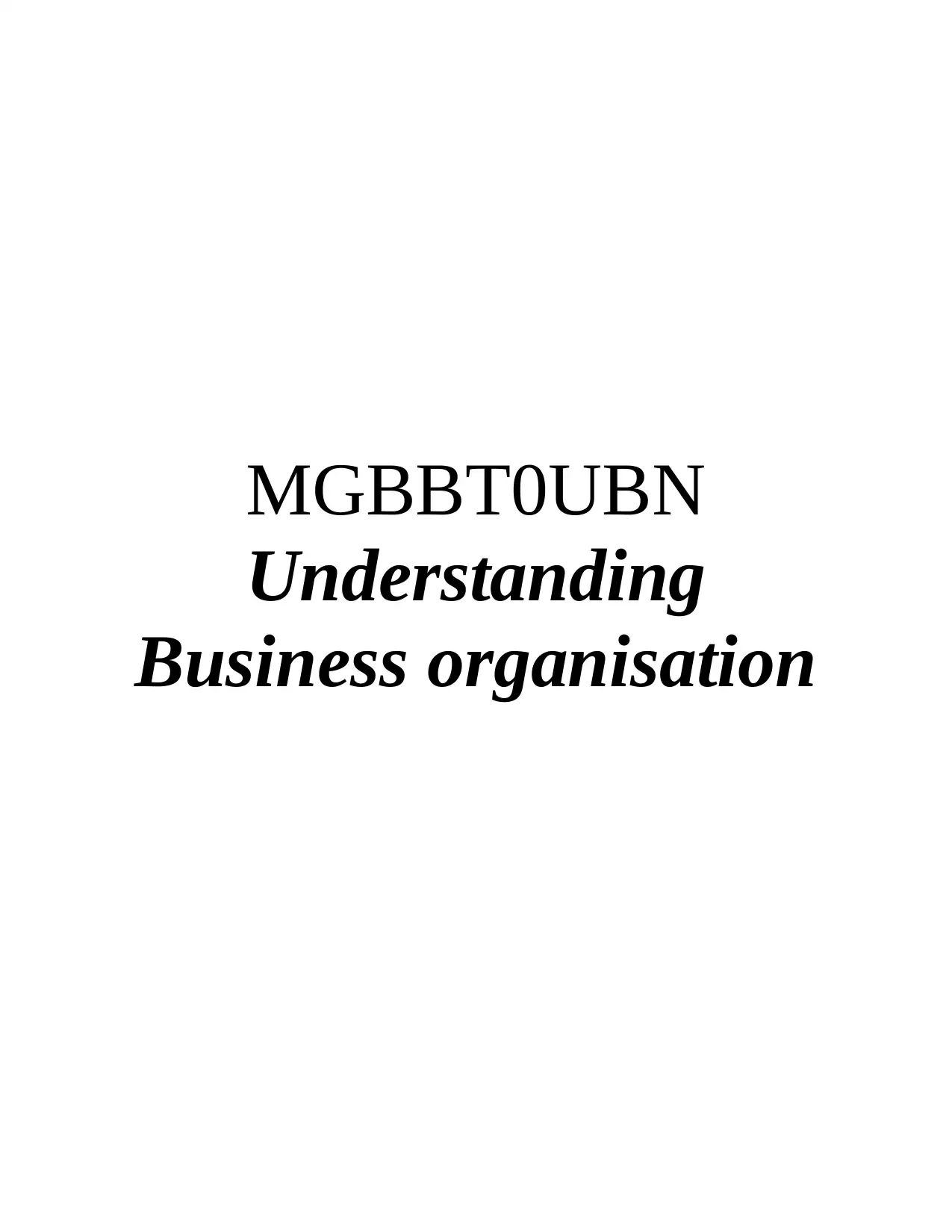
MGBBT0UBN
Understanding
Business organisation
Understanding
Business organisation
Paraphrase This Document
Need a fresh take? Get an instant paraphrase of this document with our AI Paraphraser
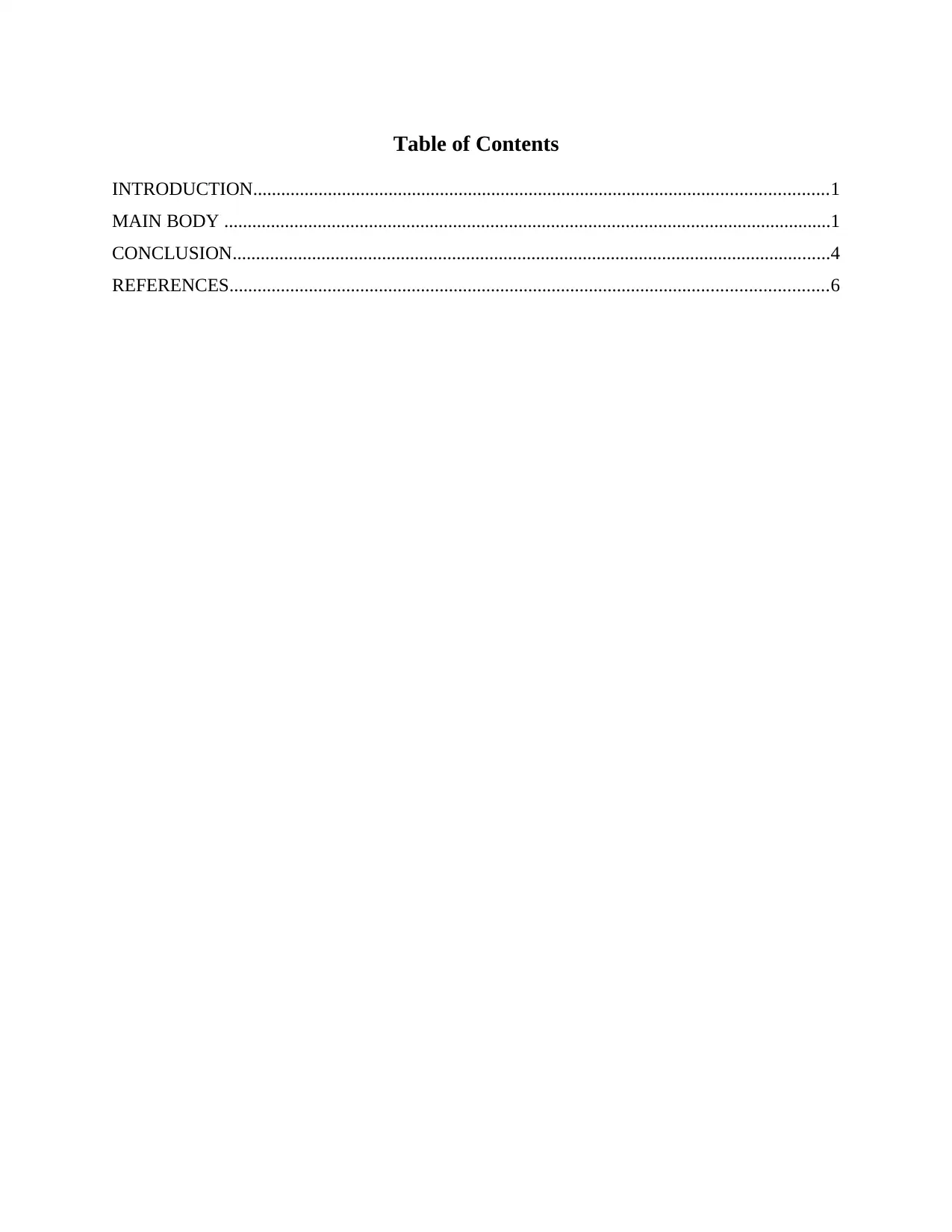
Table of Contents
INTRODUCTION...........................................................................................................................1
MAIN BODY ..................................................................................................................................1
CONCLUSION................................................................................................................................4
REFERENCES................................................................................................................................6
INTRODUCTION...........................................................................................................................1
MAIN BODY ..................................................................................................................................1
CONCLUSION................................................................................................................................4
REFERENCES................................................................................................................................6
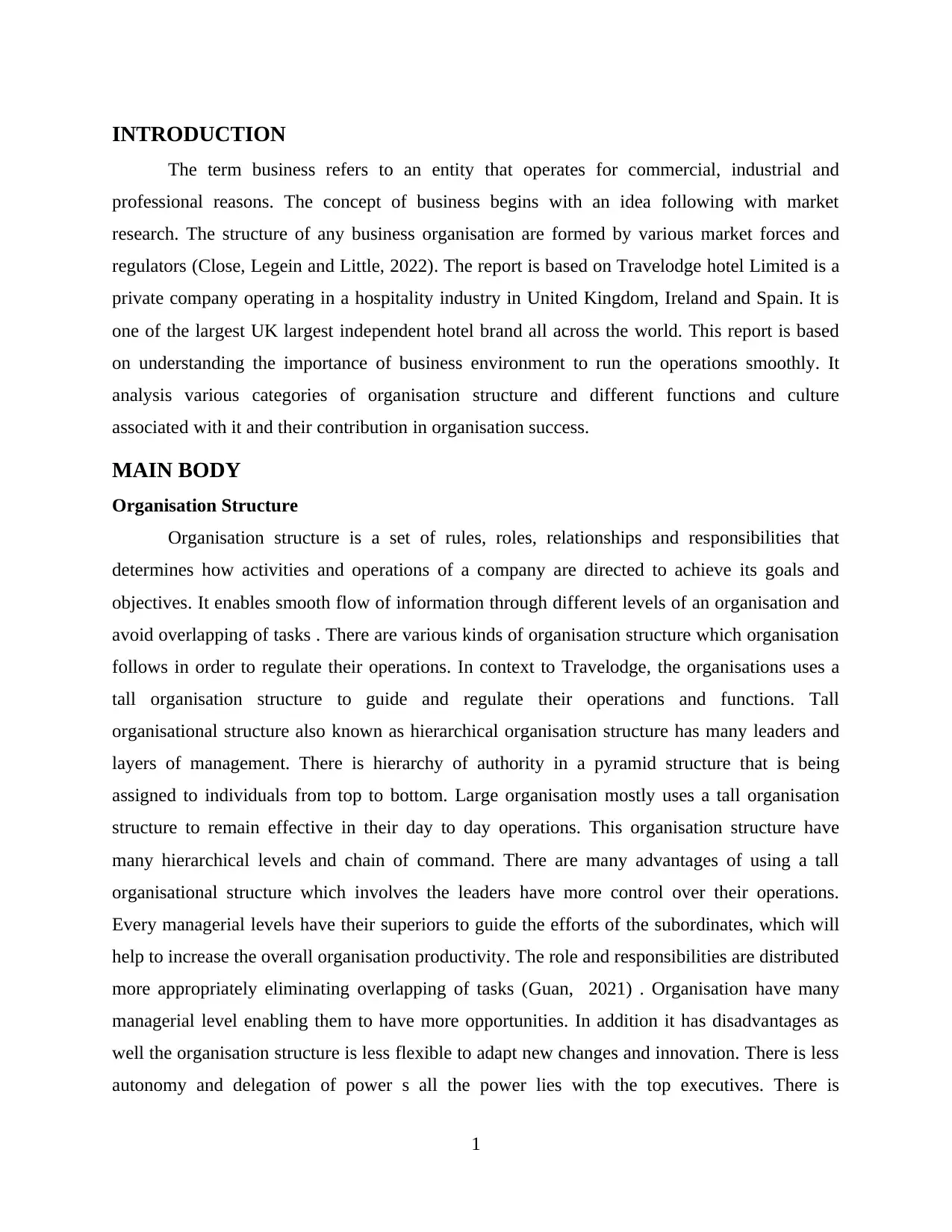
INTRODUCTION
The term business refers to an entity that operates for commercial, industrial and
professional reasons. The concept of business begins with an idea following with market
research. The structure of any business organisation are formed by various market forces and
regulators (Close, Legein and Little, 2022). The report is based on Travelodge hotel Limited is a
private company operating in a hospitality industry in United Kingdom, Ireland and Spain. It is
one of the largest UK largest independent hotel brand all across the world. This report is based
on understanding the importance of business environment to run the operations smoothly. It
analysis various categories of organisation structure and different functions and culture
associated with it and their contribution in organisation success.
MAIN BODY
Organisation Structure
Organisation structure is a set of rules, roles, relationships and responsibilities that
determines how activities and operations of a company are directed to achieve its goals and
objectives. It enables smooth flow of information through different levels of an organisation and
avoid overlapping of tasks . There are various kinds of organisation structure which organisation
follows in order to regulate their operations. In context to Travelodge, the organisations uses a
tall organisation structure to guide and regulate their operations and functions. Tall
organisational structure also known as hierarchical organisation structure has many leaders and
layers of management. There is hierarchy of authority in a pyramid structure that is being
assigned to individuals from top to bottom. Large organisation mostly uses a tall organisation
structure to remain effective in their day to day operations. This organisation structure have
many hierarchical levels and chain of command. There are many advantages of using a tall
organisational structure which involves the leaders have more control over their operations.
Every managerial levels have their superiors to guide the efforts of the subordinates, which will
help to increase the overall organisation productivity. The role and responsibilities are distributed
more appropriately eliminating overlapping of tasks (Guan, 2021) . Organisation have many
managerial level enabling them to have more opportunities. In addition it has disadvantages as
well the organisation structure is less flexible to adapt new changes and innovation. There is less
autonomy and delegation of power s all the power lies with the top executives. There is
1
The term business refers to an entity that operates for commercial, industrial and
professional reasons. The concept of business begins with an idea following with market
research. The structure of any business organisation are formed by various market forces and
regulators (Close, Legein and Little, 2022). The report is based on Travelodge hotel Limited is a
private company operating in a hospitality industry in United Kingdom, Ireland and Spain. It is
one of the largest UK largest independent hotel brand all across the world. This report is based
on understanding the importance of business environment to run the operations smoothly. It
analysis various categories of organisation structure and different functions and culture
associated with it and their contribution in organisation success.
MAIN BODY
Organisation Structure
Organisation structure is a set of rules, roles, relationships and responsibilities that
determines how activities and operations of a company are directed to achieve its goals and
objectives. It enables smooth flow of information through different levels of an organisation and
avoid overlapping of tasks . There are various kinds of organisation structure which organisation
follows in order to regulate their operations. In context to Travelodge, the organisations uses a
tall organisation structure to guide and regulate their operations and functions. Tall
organisational structure also known as hierarchical organisation structure has many leaders and
layers of management. There is hierarchy of authority in a pyramid structure that is being
assigned to individuals from top to bottom. Large organisation mostly uses a tall organisation
structure to remain effective in their day to day operations. This organisation structure have
many hierarchical levels and chain of command. There are many advantages of using a tall
organisational structure which involves the leaders have more control over their operations.
Every managerial levels have their superiors to guide the efforts of the subordinates, which will
help to increase the overall organisation productivity. The role and responsibilities are distributed
more appropriately eliminating overlapping of tasks (Guan, 2021) . Organisation have many
managerial level enabling them to have more opportunities. In addition it has disadvantages as
well the organisation structure is less flexible to adapt new changes and innovation. There is less
autonomy and delegation of power s all the power lies with the top executives. There is
1
⊘ This is a preview!⊘
Do you want full access?
Subscribe today to unlock all pages.

Trusted by 1+ million students worldwide
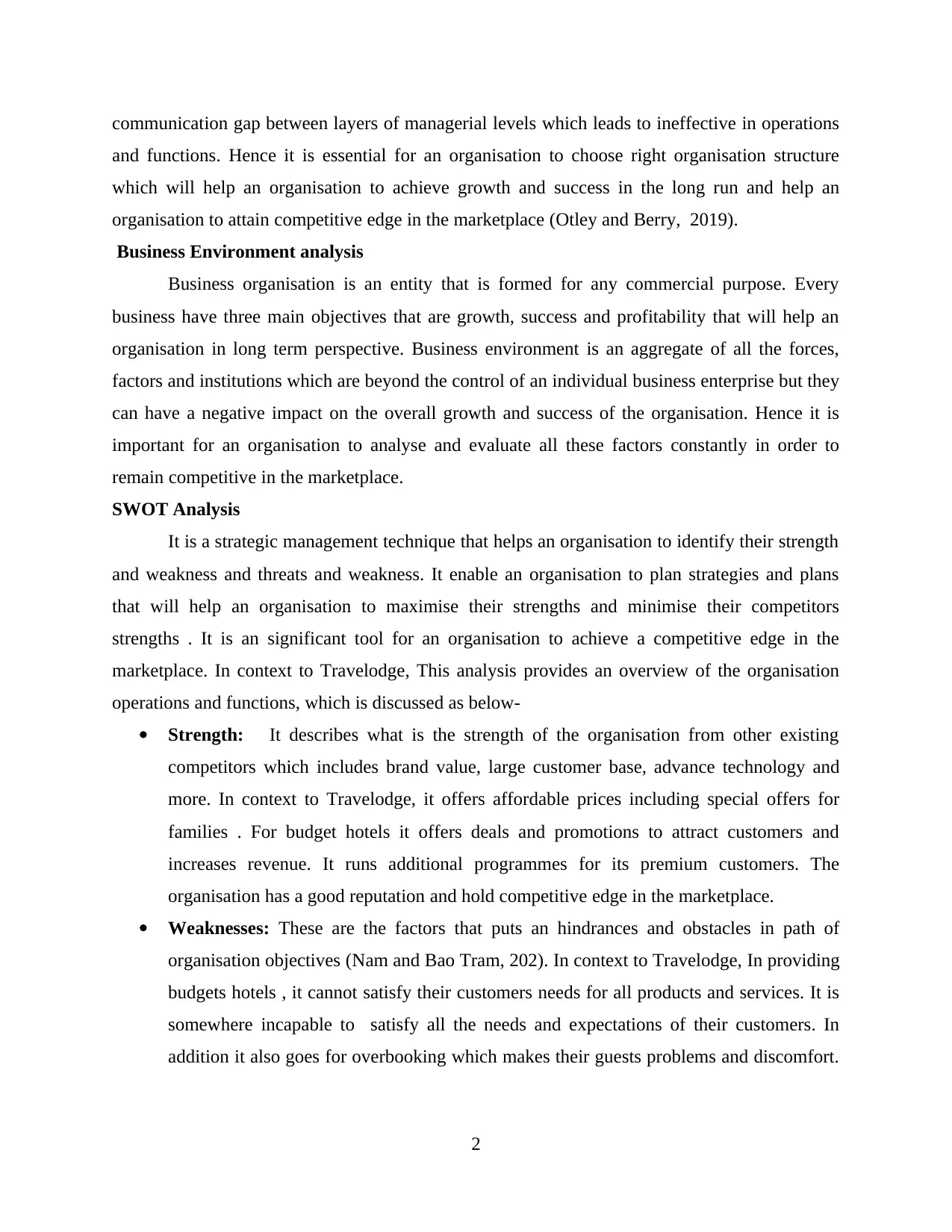
communication gap between layers of managerial levels which leads to ineffective in operations
and functions. Hence it is essential for an organisation to choose right organisation structure
which will help an organisation to achieve growth and success in the long run and help an
organisation to attain competitive edge in the marketplace (Otley and Berry, 2019).
Business Environment analysis
Business organisation is an entity that is formed for any commercial purpose. Every
business have three main objectives that are growth, success and profitability that will help an
organisation in long term perspective. Business environment is an aggregate of all the forces,
factors and institutions which are beyond the control of an individual business enterprise but they
can have a negative impact on the overall growth and success of the organisation. Hence it is
important for an organisation to analyse and evaluate all these factors constantly in order to
remain competitive in the marketplace.
SWOT Analysis
It is a strategic management technique that helps an organisation to identify their strength
and weakness and threats and weakness. It enable an organisation to plan strategies and plans
that will help an organisation to maximise their strengths and minimise their competitors
strengths . It is an significant tool for an organisation to achieve a competitive edge in the
marketplace. In context to Travelodge, This analysis provides an overview of the organisation
operations and functions, which is discussed as below-
Strength: It describes what is the strength of the organisation from other existing
competitors which includes brand value, large customer base, advance technology and
more. In context to Travelodge, it offers affordable prices including special offers for
families . For budget hotels it offers deals and promotions to attract customers and
increases revenue. It runs additional programmes for its premium customers. The
organisation has a good reputation and hold competitive edge in the marketplace.
Weaknesses: These are the factors that puts an hindrances and obstacles in path of
organisation objectives (Nam and Bao Tram, 202). In context to Travelodge, In providing
budgets hotels , it cannot satisfy their customers needs for all products and services. It is
somewhere incapable to satisfy all the needs and expectations of their customers. In
addition it also goes for overbooking which makes their guests problems and discomfort.
2
and functions. Hence it is essential for an organisation to choose right organisation structure
which will help an organisation to achieve growth and success in the long run and help an
organisation to attain competitive edge in the marketplace (Otley and Berry, 2019).
Business Environment analysis
Business organisation is an entity that is formed for any commercial purpose. Every
business have three main objectives that are growth, success and profitability that will help an
organisation in long term perspective. Business environment is an aggregate of all the forces,
factors and institutions which are beyond the control of an individual business enterprise but they
can have a negative impact on the overall growth and success of the organisation. Hence it is
important for an organisation to analyse and evaluate all these factors constantly in order to
remain competitive in the marketplace.
SWOT Analysis
It is a strategic management technique that helps an organisation to identify their strength
and weakness and threats and weakness. It enable an organisation to plan strategies and plans
that will help an organisation to maximise their strengths and minimise their competitors
strengths . It is an significant tool for an organisation to achieve a competitive edge in the
marketplace. In context to Travelodge, This analysis provides an overview of the organisation
operations and functions, which is discussed as below-
Strength: It describes what is the strength of the organisation from other existing
competitors which includes brand value, large customer base, advance technology and
more. In context to Travelodge, it offers affordable prices including special offers for
families . For budget hotels it offers deals and promotions to attract customers and
increases revenue. It runs additional programmes for its premium customers. The
organisation has a good reputation and hold competitive edge in the marketplace.
Weaknesses: These are the factors that puts an hindrances and obstacles in path of
organisation objectives (Nam and Bao Tram, 202). In context to Travelodge, In providing
budgets hotels , it cannot satisfy their customers needs for all products and services. It is
somewhere incapable to satisfy all the needs and expectations of their customers. In
addition it also goes for overbooking which makes their guests problems and discomfort.
2
Paraphrase This Document
Need a fresh take? Get an instant paraphrase of this document with our AI Paraphraser
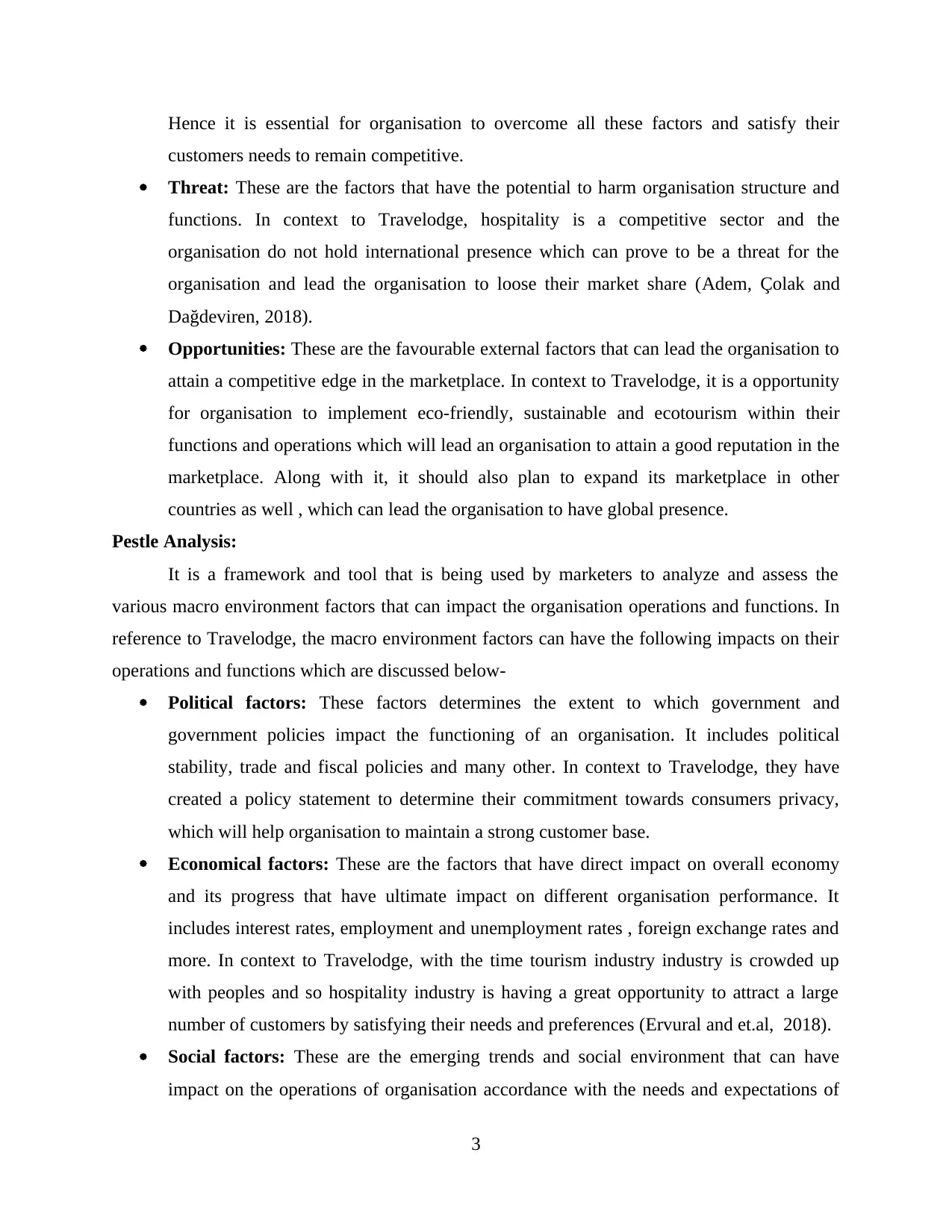
Hence it is essential for organisation to overcome all these factors and satisfy their
customers needs to remain competitive.
Threat: These are the factors that have the potential to harm organisation structure and
functions. In context to Travelodge, hospitality is a competitive sector and the
organisation do not hold international presence which can prove to be a threat for the
organisation and lead the organisation to loose their market share (Adem, Çolak and
Dağdeviren, 2018).
Opportunities: These are the favourable external factors that can lead the organisation to
attain a competitive edge in the marketplace. In context to Travelodge, it is a opportunity
for organisation to implement eco-friendly, sustainable and ecotourism within their
functions and operations which will lead an organisation to attain a good reputation in the
marketplace. Along with it, it should also plan to expand its marketplace in other
countries as well , which can lead the organisation to have global presence.
Pestle Analysis:
It is a framework and tool that is being used by marketers to analyze and assess the
various macro environment factors that can impact the organisation operations and functions. In
reference to Travelodge, the macro environment factors can have the following impacts on their
operations and functions which are discussed below-
Political factors: These factors determines the extent to which government and
government policies impact the functioning of an organisation. It includes political
stability, trade and fiscal policies and many other. In context to Travelodge, they have
created a policy statement to determine their commitment towards consumers privacy,
which will help organisation to maintain a strong customer base.
Economical factors: These are the factors that have direct impact on overall economy
and its progress that have ultimate impact on different organisation performance. It
includes interest rates, employment and unemployment rates , foreign exchange rates and
more. In context to Travelodge, with the time tourism industry industry is crowded up
with peoples and so hospitality industry is having a great opportunity to attract a large
number of customers by satisfying their needs and preferences (Ervural and et.al, 2018).
Social factors: These are the emerging trends and social environment that can have
impact on the operations of organisation accordance with the needs and expectations of
3
customers needs to remain competitive.
Threat: These are the factors that have the potential to harm organisation structure and
functions. In context to Travelodge, hospitality is a competitive sector and the
organisation do not hold international presence which can prove to be a threat for the
organisation and lead the organisation to loose their market share (Adem, Çolak and
Dağdeviren, 2018).
Opportunities: These are the favourable external factors that can lead the organisation to
attain a competitive edge in the marketplace. In context to Travelodge, it is a opportunity
for organisation to implement eco-friendly, sustainable and ecotourism within their
functions and operations which will lead an organisation to attain a good reputation in the
marketplace. Along with it, it should also plan to expand its marketplace in other
countries as well , which can lead the organisation to have global presence.
Pestle Analysis:
It is a framework and tool that is being used by marketers to analyze and assess the
various macro environment factors that can impact the organisation operations and functions. In
reference to Travelodge, the macro environment factors can have the following impacts on their
operations and functions which are discussed below-
Political factors: These factors determines the extent to which government and
government policies impact the functioning of an organisation. It includes political
stability, trade and fiscal policies and many other. In context to Travelodge, they have
created a policy statement to determine their commitment towards consumers privacy,
which will help organisation to maintain a strong customer base.
Economical factors: These are the factors that have direct impact on overall economy
and its progress that have ultimate impact on different organisation performance. It
includes interest rates, employment and unemployment rates , foreign exchange rates and
more. In context to Travelodge, with the time tourism industry industry is crowded up
with peoples and so hospitality industry is having a great opportunity to attract a large
number of customers by satisfying their needs and preferences (Ervural and et.al, 2018).
Social factors: These are the emerging trends and social environment that can have
impact on the operations of organisation accordance with the needs and expectations of
3
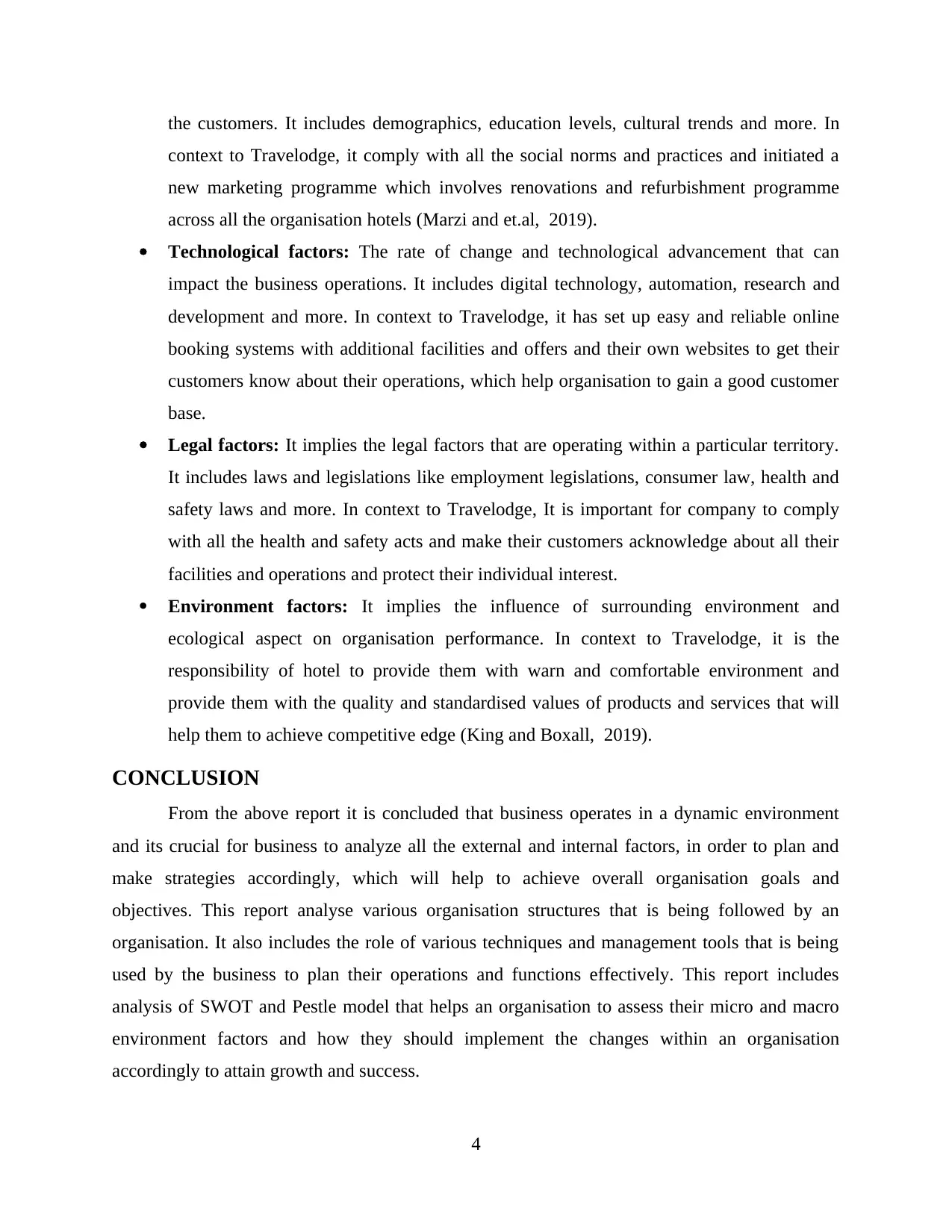
the customers. It includes demographics, education levels, cultural trends and more. In
context to Travelodge, it comply with all the social norms and practices and initiated a
new marketing programme which involves renovations and refurbishment programme
across all the organisation hotels (Marzi and et.al, 2019).
Technological factors: The rate of change and technological advancement that can
impact the business operations. It includes digital technology, automation, research and
development and more. In context to Travelodge, it has set up easy and reliable online
booking systems with additional facilities and offers and their own websites to get their
customers know about their operations, which help organisation to gain a good customer
base.
Legal factors: It implies the legal factors that are operating within a particular territory.
It includes laws and legislations like employment legislations, consumer law, health and
safety laws and more. In context to Travelodge, It is important for company to comply
with all the health and safety acts and make their customers acknowledge about all their
facilities and operations and protect their individual interest.
Environment factors: It implies the influence of surrounding environment and
ecological aspect on organisation performance. In context to Travelodge, it is the
responsibility of hotel to provide them with warn and comfortable environment and
provide them with the quality and standardised values of products and services that will
help them to achieve competitive edge (King and Boxall, 2019).
CONCLUSION
From the above report it is concluded that business operates in a dynamic environment
and its crucial for business to analyze all the external and internal factors, in order to plan and
make strategies accordingly, which will help to achieve overall organisation goals and
objectives. This report analyse various organisation structures that is being followed by an
organisation. It also includes the role of various techniques and management tools that is being
used by the business to plan their operations and functions effectively. This report includes
analysis of SWOT and Pestle model that helps an organisation to assess their micro and macro
environment factors and how they should implement the changes within an organisation
accordingly to attain growth and success.
4
context to Travelodge, it comply with all the social norms and practices and initiated a
new marketing programme which involves renovations and refurbishment programme
across all the organisation hotels (Marzi and et.al, 2019).
Technological factors: The rate of change and technological advancement that can
impact the business operations. It includes digital technology, automation, research and
development and more. In context to Travelodge, it has set up easy and reliable online
booking systems with additional facilities and offers and their own websites to get their
customers know about their operations, which help organisation to gain a good customer
base.
Legal factors: It implies the legal factors that are operating within a particular territory.
It includes laws and legislations like employment legislations, consumer law, health and
safety laws and more. In context to Travelodge, It is important for company to comply
with all the health and safety acts and make their customers acknowledge about all their
facilities and operations and protect their individual interest.
Environment factors: It implies the influence of surrounding environment and
ecological aspect on organisation performance. In context to Travelodge, it is the
responsibility of hotel to provide them with warn and comfortable environment and
provide them with the quality and standardised values of products and services that will
help them to achieve competitive edge (King and Boxall, 2019).
CONCLUSION
From the above report it is concluded that business operates in a dynamic environment
and its crucial for business to analyze all the external and internal factors, in order to plan and
make strategies accordingly, which will help to achieve overall organisation goals and
objectives. This report analyse various organisation structures that is being followed by an
organisation. It also includes the role of various techniques and management tools that is being
used by the business to plan their operations and functions effectively. This report includes
analysis of SWOT and Pestle model that helps an organisation to assess their micro and macro
environment factors and how they should implement the changes within an organisation
accordingly to attain growth and success.
4
⊘ This is a preview!⊘
Do you want full access?
Subscribe today to unlock all pages.

Trusted by 1+ million students worldwide

5
Paraphrase This Document
Need a fresh take? Get an instant paraphrase of this document with our AI Paraphraser

REFERENCES
Books and Journals
Adem, Çolak and Dağdeviren, 2018. An integrated model using SWOT analysis and Hesitant
fuzzy linguistic term set for evaluation occupational safety risks in life cycle of wind
turbine. Safety science, 106, pp.184-190.
Close, Legein and Little, 2022. Party organisation and the party-delegate style of
representation. Party Politics, p.13540688221122332.
Ervural and et.al, 2018. An ANP and fuzzy TOPSIS-based SWOT analysis for Turkey’s energy
planning. Renewable and Sustainable Energy Reviews, 82, pp.1538-1550.
Guan, 2021. The Southeast Asia Treaty Organisation. Routledge.
King and Boxall, 2019. Lithium battery recycling in Australia: Defining the status and
identifying opportunities for the development of a new industry. Journal of Cleaner
Production, 215, pp.1279-1287.
Marzi and et.al, 2019. Competence analysis for promoting energy efficiency projects in
developing countries: The case of OPEC. Energy, 189, p.115996.
Nam and Bao Tram, 2021. Business environment and innovation persistence: The case of small-
and medium-sized enterprises in Vietnam. Economics of Innovation and New
Technology, 30(3), pp.239-261.
Otley and Berry, 2019. Control, organisation and accounting. In Management Control
Theory (pp. 101-114). Routledge.
6
Books and Journals
Adem, Çolak and Dağdeviren, 2018. An integrated model using SWOT analysis and Hesitant
fuzzy linguistic term set for evaluation occupational safety risks in life cycle of wind
turbine. Safety science, 106, pp.184-190.
Close, Legein and Little, 2022. Party organisation and the party-delegate style of
representation. Party Politics, p.13540688221122332.
Ervural and et.al, 2018. An ANP and fuzzy TOPSIS-based SWOT analysis for Turkey’s energy
planning. Renewable and Sustainable Energy Reviews, 82, pp.1538-1550.
Guan, 2021. The Southeast Asia Treaty Organisation. Routledge.
King and Boxall, 2019. Lithium battery recycling in Australia: Defining the status and
identifying opportunities for the development of a new industry. Journal of Cleaner
Production, 215, pp.1279-1287.
Marzi and et.al, 2019. Competence analysis for promoting energy efficiency projects in
developing countries: The case of OPEC. Energy, 189, p.115996.
Nam and Bao Tram, 2021. Business environment and innovation persistence: The case of small-
and medium-sized enterprises in Vietnam. Economics of Innovation and New
Technology, 30(3), pp.239-261.
Otley and Berry, 2019. Control, organisation and accounting. In Management Control
Theory (pp. 101-114). Routledge.
6
1 out of 8
Related Documents
Your All-in-One AI-Powered Toolkit for Academic Success.
+13062052269
info@desklib.com
Available 24*7 on WhatsApp / Email
![[object Object]](/_next/static/media/star-bottom.7253800d.svg)
Unlock your academic potential
Copyright © 2020–2025 A2Z Services. All Rights Reserved. Developed and managed by ZUCOL.





